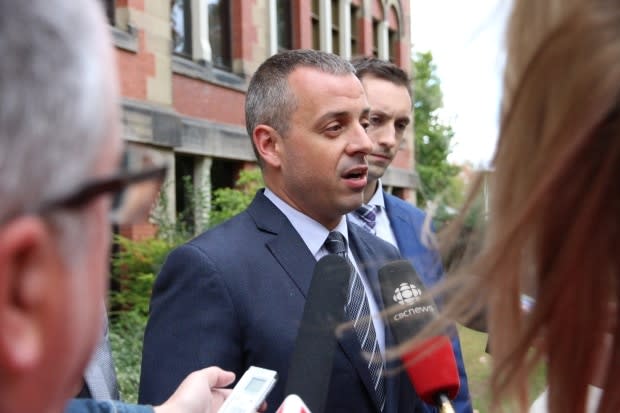Trial date moved up for Matthew Raymond case, complaint against former judge unsealed
The new judge on the Matthew Raymond case has moved up the criminal trial to Sept. 15 at the request of the defence.
The previous judge, Justice Fred Ferguson, set the trial date for Sept. 28. But defence lawyer Nathan Gorham made an application Thursday for Justice Larry Landry to overturn that decision and set an earlier date.
Raymond, who's accused of four counts of first degree murder in the shooting deaths of Cst. Sara Burns, Cst. Robb Costello, Donnie Robichaud and Bobbie Lee Wright two summers ago, is set to begin his second fitness hearing Monday.
That's when jury selection will begin for the fitness hearing, and possibly the criminal trial. The jury selected will be the first in Canada chosen post-COVID-19. If he's found fit, Raymond can choose to keep this jury for his criminal trial.

Gorham argued having six weeks between the beginning of the fitness hearing and criminal trials poses too many risks. He said if his client keeps the same jury, some jurors may find the wait too long between the two trials. Lose enough jurors, and there's a mistrial, he argued. Justice Landry said he does not see that argument as anything more than speculation and did not put that much weight to it when he made his decision.
What he said he did put weight on were the scheduling conflicts, and risks of losing fitness of the defendant, he said at the hearing Friday. Gorham has another trial in Ontario which is cutting it quite close to the end of the multiple-week Raymond trial.
"I try as much as a I can to accommodate lawyers from all parties," Landry said. So he considered factors like right of accused to lawyers of choice as well as the heavy workload of back-to-back major trials.
Gorham was originally asking for the trial to be moved to Sept. 7, but Crown lawyer Darlene Blunston argued all witnesses have already been given a timeline, and there are some witnesses who will be coming from outside the Atlantic bubble and might need to self isolate.
Sealed documents unsealed
Media, the public, lawyers and judges can now access documents about the recusal of the last judge on the Raymond case.
On Friday morning Chief Justice of the Court of Queen's Bench Tracey DeWare unsealed the documents relating to the defence's application to have Ferguson recuse himself. They were three letters and an affidavit from a member of the defence team.
The affidavit alleges that after media reports of Gorham filing the recusal application, he was contacted independently by two people who also had issues with the judge.
Gorham said he felt he has an "ethical obligation" to follow up on their complaints. He sent a member of his team, Alex Pate, to Miramichi court to request transcripts and verify one of the people's claims. Pate's affidavit alleges when he got to the court, Ferguson was there, took him aside and asked him why he wants those transcripts.
Gorham told the court the "ex-parte" meeting was "inappropriate" and led to him sending a letter to the chief justice. Shortly after, Ferguson recused himself
Ferguson stepped down before the application was heard, rendering the application moot. Because of this, and several other reasons including protecting the privacy of third parties mentioned, DeWare sealed the three letters and an affidavit.
David Coles, the lawyer representing CBC, CTV and Global News, argued a sealing order was not appropriate because just because an application is moot does not mean it should be scrubbed from the record. He also said people deserve to know the reasons why the judge recused himself, since he did so only after the evidence was submitted.
Gorham argued to have the evidence unsealed as well, because he said the decision to seal it furthered the narrative that the defence team was "unfocused" and that his complaint was "unfounded."
The two people who approached Gorham were represented by a lawyer who argued for the evidence to be unsealed as well, and said her clients want to be identified.
DeWare unsealed the evidence, but placed several publication bans including one on the names of those two people and their case numbers.

